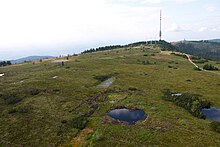Grind
Grinde is the name for the almost tree-free wet heaths on the flattened red sandstone ridges of the northern Black Forest . The Grinden had their greatest extent at the beginning of the 19th century. They stretched from Kniebis near Freudenstadt in the south to the heights near Dobel in the north. Today the Grinden areas are limited to the highest locations in the northern Black Forest around Hornisgrinde , Schliffkopf and Kniebis (900 to 1164 m above sea level ). They still cover an area of approx. 180 hectares. By means of maintenance measures and targeted grazing with robust cattle breeds (back forests ), goats and sheep , the remaining Grinden should be preserved because of their great ecological value and because of their landscape-defining importance. They are largely under nature protection .
Word origin and meaning
The term "Grinde" comes from Old High German and is related to the Swabian-Alemannic term " Grind ", which means something like "bald head". This term was transferred to the forest-free (bare) mountain tops (heads).
Origin and use
The grinds are mainly caused by human influence. Due to the population growth in the 14th century, the areas for livestock farming in the valleys of the Black Forest were no longer sufficient. For this reason, cattle and goats were driven to graze on the flat plateaus with their loose trees. The so-called pasture burning at the end of the pasture year served to prevent tree growth, promote grass growth and enlarge the pasture areas. By using the plateau as pastures, the meadows near the house could be reserved for hay extraction. The overgrazing of the plateaus as early as the 16th century led to a loss of nutrients and soil compaction. Due to the high precipitation of up to 2,200 mm / year, waterlogging and bog formation were the consequences. These processes led to the development of the pits.
Pasture farming on the Grinden existed for 500 years until the 19th century. In the middle of the 18th century, pasture burning had destroyed such large areas of forest that it was banned. With the advent of stable keeping came the end of grazing. However, the grinds were still used for hay extraction, mainly because of the goat grass ( Borstgras , Nardus stricta), which the farmers ascribed a healing effect on the animals. In the mid- 1950s , with the decline in livestock farming , this form of farming was also increasingly abandoned. With the end of the agricultural use of the Grinden, the forest gradually began to reclaim the land. In addition to natural reforestation through the approach of pines, especially mountain pines (mountain pines), planned reforestation began at the end of the 18th century . The Grinden on the Enzhöhen was therefore forested again in the 19th century.
Flora and fauna
The scabs are on the poor soils of the major conglomerate of red sandstone , which contributes significantly to the characteristic Grind ecology.
Characteristic plant: Nardus , German deergrass , moor grass , heather , blueberry , cranberry , bilberry , mountain pine , peat moss , Schei Diges cotton grass .
Characteristic animals: capercaillie , hazel grouse .
literature
- Wolfgang Schlund (text), nature conservation center Ruhestein (ed.): The Grindenschwarzwald. (Media combination), pk-Verlag, Freiamt o. J., ISBN 3-9810385-0-9
- Ludwig Schülli: The state forest Kaltenbronn: an example of the development of forestry in the forests of the northern Black Forest during the last 200 years. Series of publications of the state forest administration Baden-Württemberg vol. 8; Maly, Karlsruhe 1959
Web links
- LIFE project "Grindenschwarzwald" ( regional council Karlsruhe)
